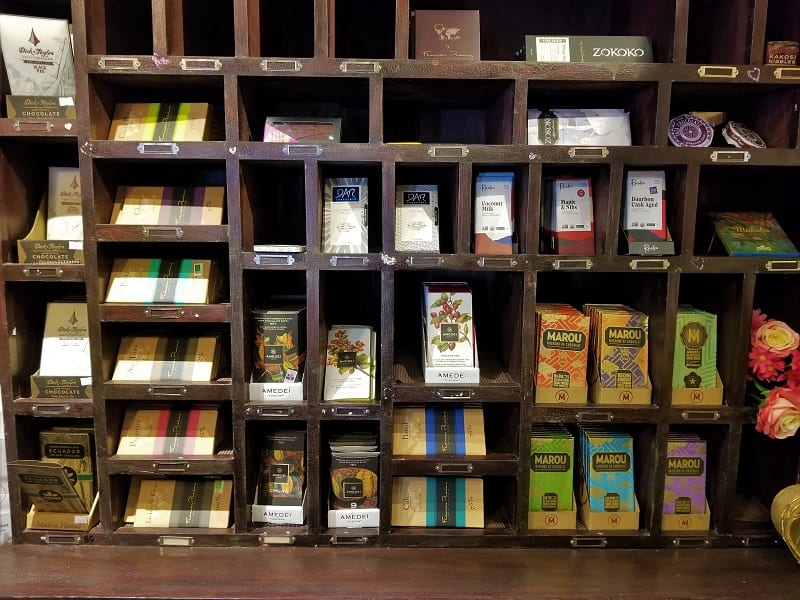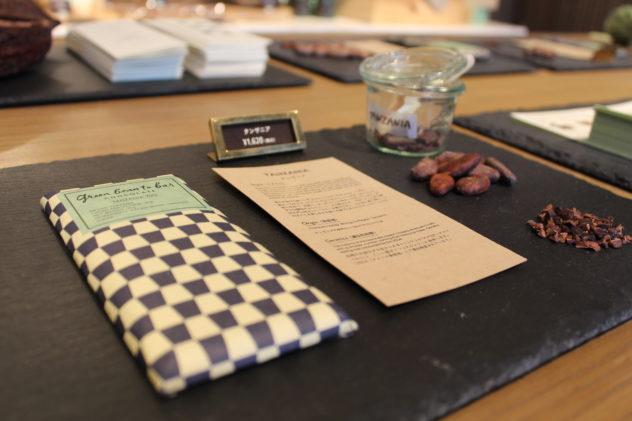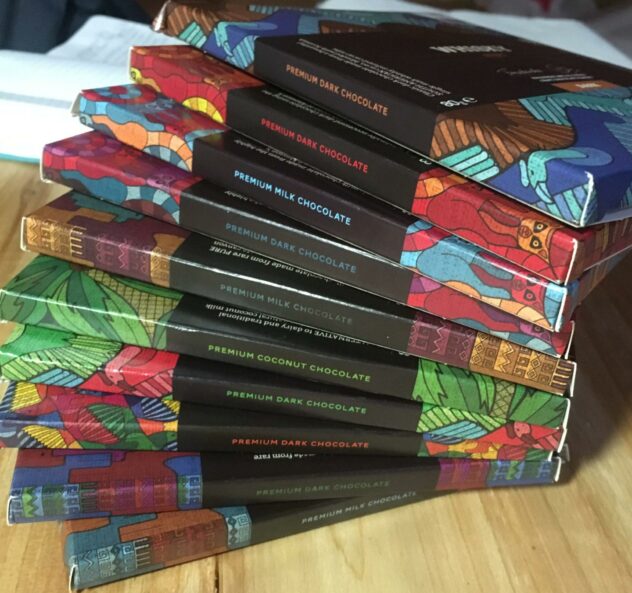This page is also known as The Guide to Impressing Your Friends by Leading a Craft Chocolate Tasting.
Before we deep dive into chocolate, be sure you've read up on what craft chocolate is, and why it's important to use craft chocolate and not just any bar you find in the store. Yet just like juggling or traveling alone, leading a craft chocolate tasting isn't nearly as scary as you might think. The first step is to just try it.

What is a Tasting Note?
There's a whole spectrum of flavors out there, and the array is completely different from person to person. Even the names for common flavors can vary from person to person. But first let's address taste; there's no accounting for it, right?
Well, actually there is. Taste as we experience it largely comes from what is interpreted by the olfactory receptors in your nose and mouth. Most of any flavor is its smell. Think of when you last had a cold, and you couldn't taste a thing with that stuffy nose.
Or when you ate a delicious dessert and forgot to brush your teeth, and then sneezed. Suddenly you were tasting dessert again. Such deadening or revival of flavor is thanks to the location of your strongest flavor receptors— in your nose.
A tasting note is a unique combination of the five basic flavors and the texture of a chocolate, as interpreted by your taste buds & through your own personal memories. In that sense, no two people will ever experience the same tasting notes in a craft chocolate bar, because no two people have the same exact memories.

What Are the Five Basic Flavors?
In terms of basic flavors detectable in food, there is much debate. Traditionally it has been thought that there is sweet, salty, bitter, sour, and recently, umami (meaty/savoury). Though nowadays, scientists are also searching for proof of fat flavor receptors. But think of the best chocolate you've ever had.
Was it just one of those flavors, or a blend? Your brain naturally craves complexity in food, because that historically indicated a more nutritionally balanced meal. The flavors in a good bar of chocolate are equally intertwined. Each of the five traditional building blocks have their own nuanced sub-flavors.
Some more common flavors detected in chocolate, often called "tasting notes," are: tannin, floral, fudge, creamy, nutty, bitter, earthy, red fruit, and citrus. Each of these is itself a blend of basic flavors, so differentiating them is a challenge. You must rely on your past experiences with these flavors in order to identify them.
While some can seem obvious, take "citrus" for instance, for the most part your palate will require some training (Yes, chocolate exercises! Finally!) before you can consistently detect these nuances. This tasting method is similar to the approach to tasting wine, and is not the only approach out there.

3 Tips to Start Tasting Today
Organizing a tasting is not as simple as finding the first five pretty bars on a shelf in the grocery store and heading to check out. If it were that simple, then everyone with a Snickers bar would be a chocolate taster & everyone with a bottle of Barefoot would be a wine connoisseur.
The key to a successful tasting is distinction. You, as the head taster, need to do the hard work of tasting several chocolates before you narrow down your selection. How will you ever bear such a weighty burden? Well first you need to go shopping with these three tips in mind:
- Start off with lower percentages (60-70%, and possibly one mild 75%).
- If there are flavor notes on the bar, look for bars that say "creamy," "caramel," and "floral" (avoid "earthy," "tannins," and "tobacco").
- Look for single-origin bars which feature salt, preferably sprinkled on the back of the bar. Salt makes the chocolate taste sweeter, without taking away as much of the flavor nuance as milk powder does. You also don't have to chew salt, unlike many other sweetening ingredients, making it tasting-friendly.
Though strong flavor notes are occasionally present in high percentage milk chocolates, the presence of milk powder tends to dull flavor notes. The more nuanced flavors are most easily detectable in dark chocolates. This can mean that many people never experience or seek out these flavors, however, because so many people have written off dark chocolate as too bitter.
But this is because there are indeed tricks to finding & trying & liking dark chocolates, if you usually stick to milk chocolates. So next time you're in the chocolate or health food store, keep three things in mind: 60-70% cacao, yummy-sounding tasting notes, and salt on the back.

Bitter Chocolate & Other Complaints
Another key to really enjoying your dark chocolate, as well as being more knowledgeable at your tasting, is learning the difference between bitterness, tannins, and a simple lack of sugar.
Bitterness is a characteristic of grapefruit or any number of herbs. Tasting something bitter often makes people want to stick their tongues out, maybe in the hopes that the offending substance just slides right off. Tannins are present in high amounts in red wine; it's that flavor that makes you smack your lips with dryness.
A simple lack of sugar is a characteristic that often confuses people into thinking that something's bitter. We have come to associate chocolate with sugary sweetness, but quality chocolate doesn't necessarily have sugar.
However, a 70% chocolate bar is 30% sugar. So if a 70% bar tastes not-sweet to you, it is indeed probably due to high tannin or bitterness rather than lack of sugar. But let the mouthfeel of a chocolate also help you out here: tannins taste heavier in your mouth; they have more of a presence.
Bitterness makes your face scrunch up, but does not have any real weight. Lack of sugar is usually just a surprise, but not necessarily unpleasant. Sometimes negative tasting notes are also simply the result of a negative association of certain natural flavors.
Mushroom and earthiness may seem out of place at first, but they can add depth to a complex chocolate flavor. Another consideration is that you just bought or were given bad chocolate. Not every bar is a winner.
The market is dominated by cheap chocolate, often made using cheap cacao, which can be tainted without proper vigilance. Sometimes chemicals fall in, or too much husk is left behind in winnowing, or cacao was stored badly and mold grew, or debris was left in the cacao after lackadaisical sorting.
Hundreds of little things can go wrong, and leave you tasting unhappy chocolate.

How Experts Taste Chocolate
Now that you know more of what to look for when experiencing new chocolates, here are the steps I go through when writing a bar review:
1. If you're just starting out, look at the packaging for tasting notes from the chocolate maker, or even just an origin. Country of origin can tell the buyer a lot about the product they are purchasing. Although not all Papua New Guinean or Trinidadian beans are smoky, or Madagascan beans fruity, flavor trends of beans from certain origins can give you more of an idea of what to expect.
More seasoned tasters tend to avoid getting any preconceived flavor notions in their minds, but for those still exploring and developing their palates, it's a good idea to be aware of those who have tasted before you.
2. Take the bar itself out of it's packaging. Take note of whether you like the aluminum, plastic, or paper inner wrapping the best. Even subconsciously, it adds to or subtracts from the experience. Nobody likes forcing chocolate back into a torn wrapper.
3. Smell the bar. Think of what memories and smells it recalls, whether that be a specific fruit, a favorite dish or a relative coming to visit. Our sense of smell— and therefore our sense of taste— is highly connected to our memory.
Even just placing the smell of a bar into a specific setting can help us identify any hidden notes. Set the bar down, or reseal it, and come back to it in a few minutes if you can, because you may smell different notes a bit later.
4. Snap a piece of the bar off, noting whether there is a distinct snap, or if it just breaks in half with little to no flair. A good snap is indicative of well-tempered chocolate, and generally means that the flavors of a bar will stay strong and the fat will melt steadily for a longer time, continuing to release unique flavors.

5. Put that piece of chocolate in your mouth. Break it up with your teeth a few times, and then just let it melt. As the cocoa butter melts, it is releasing all of the flavors of the beans. So if you just chew it straight off the bat, you could miss some very enjoyable tasting notes at the beginning.
Some bars have a weird unappealing quality that you cannot put your finger on, and often that's a clumpy melt, which can also make unique flavors less detectable. A good chocolate bar will have several flavors at play, and evolves from one flavor to the next as the bar melts in your mouth.
Move around the chocolate nub so that it touches each corner of your tongue, because current research says that each part of the tongue is a little better at detecting specific flavors.
6. Once the bar has melted and been mostly consumed, you can think about how the "finish" is, i.e. whether the flavor of the bar sticks in your mouth, and what that or those flavors are. Once the "finish" is about done, you can take a few sips of water and go in for another taste if you'd like... you never know what you might find this round!
7. Remember, this is still chocolate. Have fun with it. It will take some time to develop a sensitive palate and an idea of your own likes & dislikes. Try a lot of different makers and origins and percentages, because you never know what you'll find!

Considerations When Conducting a Tasting
Everyone tastes different things. It's worth having each friend or participant get a tasting notebook. During the quiet tasting period, have everybody write down the flavors they taste in each bar, comparing notes later (maybe over a glass of wine!).
One minute of quiet time should suffice, per bar, and remember not to overload your palate with too many bars one after the other (5-7 is a good number for a tasting). Blind tastings are an interesting way to better draw out each person's unique tastes.
Without the distraction of pretty packaging or specific percentages, we can use our taste buds more freely. To turn your tasting party into a blind one, simply remove your chocolates from their packaging and put them each on their own plates with only a number as an identifier.
Try to hide any distinct shapes or names in the mold by cutting it up into small pieces. Keep a key & reveal the bars at the end, but not before people guess which bar was which!
When tasting a range of different percentages, when you first start running tastings, arrange the lineup with the highest percentages of cacao tasted first. If there are any inclusions, these should be put last together, again keeping in mind the percentage of cacao.
This is due to the human tendency to perceive things as more bitter if they are less sweet than their predecessor, as well as the strong flavors of inclusions tending to influence any flavors tasted afterwards. Be cautious but welcoming towards "rustic" chocolate.
In your search for deliciousness, you are sure to come across bars labelled as rustic or old-style. This is referring to the texture, which is going to be different from the typical smoothness you have likely come to associate with chocolate.
The term "rustic" could refer to a couple of different things, including a bar with 100% chocolate + the noted amount of sugar in whole crystals, or it could refer to processing level of bar, with the bar being very grainy and often high in sugar.
I would categorize both styles under "inclusion" for the purpose of tasting. The textures are going to play with your mind a bit.

Pro-Tip: tasting cocoa beans is actually a similar process as tasting finished chocolate, but with less focus on snap and none on melt. The important thing for one to note is the difference between the flavors in the aroma and those on the tongue.
Both groups can represent potential flavors expressed in the final product, though the final product will always taste different. However, I warn you to brace yourself. Mentally prepare for beans that will rarely be sweet and are often be bitter or astringent.
For a guide to buying craft chocolate, read this article.
If you found this article helpful, please pin it so that others can find it, too!

















Jessy
I was doing research for a blog about meditating on chocolate and this really helped me out, thank you.
Max
You're very welcome! Thank you for taking the time to leave a comment. 🙂
Susan
Fabulous in-depth article! I'm planning on hosting a wine & chocolate tasing evening so this has been great research. Thank you.
Max
Thank you! I hope the event goes smoothly, Susan.